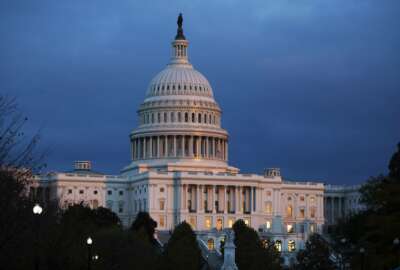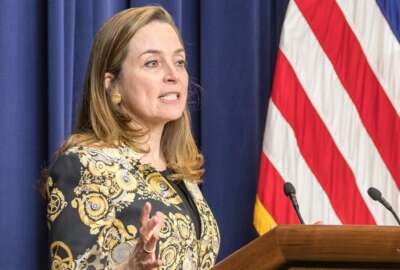
2021 budget request gives window into White House priorities
In the politically-twisted world of government budgeting, it can be hard to tell what everyone is up to.
Best listening experience is on Chrome, Firefox or Safari. Subscribe to Federal Drive’s daily audio interviews on Apple Podcasts or PodcastOne.
Budgets have often been called the financial expression of values. In the politically-twisted world of government budgeting, it can be hard to tell what everyone is up to. Now that we’ve all had a week to digest the 2021 budget proposal from the Trump administration, Federal Drive with Tom Temin reflected a little on the process with a long-time former federal budget official, now the managing director for the public sector at Grant Thornton, Doug Criscitello.
Interview transcript:
Tom Temin: Mr. Criscitello, good to have you on.
Doug Criscitello: Hey, great to be here, Tom.
Tom Temin: Let’s talk about the budget as we saw it and as we’ve all tried to digest it. What does it say, do you think, what’s really going on with the administration? And how is this an expression of what the government thinks it ought to be doing?
Doug Criscitello: Well, the 2021 budget proposal that was offered by the Trump administration this past Monday really can’t be considered in a vacuum. It’s really a part of the president’s ongoing fiscal plan to cut taxes, reduce nondefense discretionary spending and even to rely on sort of macroeconomic responses to those actions, to sort of stimulate the economy and generate additional revenues. So that budget is very consistent with what’s been proposed by the administration over the past several years.
Tom Temin: You were a CFO, and you also worked at [the Office of Management and Budget] on budgetary matters for several years. How would you describe the process by which we get to that day of release and is it really rational?
Doug Criscitello: So the modern budget process has its origins way back in 1974 — the Congressional Budget and Impoundment Control Act of 1974 — which you know, that was a major overhaul at the time. It did things like it created the Congressional Budget Office and the House and Senate Budget Committees. Best laid plans, though, because the process just hasn’t worked. We’ve only had on-time budgets four times in the past 40-plus years. We’ve had 186 continuing resolutions, 20 funding lapses, countless debt ceiling crises. And you know all of this manifest in the form of, you know, a deterioration of citizen trust. You know, we can’t even get our budget process right.
Tom Temin: And then you’ve got the issue of how much time — if you looked at it, it’s like Americans paying taxes, someone added up billions and billions and billions of man hours or person hours in the federal government. All of that work in agencies, all of that work in OMB to try to roll it up in the whole pass back and re-roll-up process. That seems like a lot of time that could be better spent or more efficiently spent.
Doug Criscitello: Yeah, it seems that budget season ever ends now. There was a time, just from the OMB perspective there was a time when there was an intense period of activity where the budget was pulled together, and then the remainder of the year was spend at OMB, you know, doing deeper dives into agency performance and to evaluating particular programs. But budget season is just endless now, not only at OMB but on the part of, you know, a large number of people at agencies because, you know, they’re juggling — within an office of the chief financial officer they’re constantly — sort of juggling three separate fiscal years, you know, closing out the last year, executing the budget of the current year and planning for the coming year. And it’s really, it pulls in many other parts of the agency and doing that, too. So the budget season, as we call it, never seems to end. So, you know all of this points to, you know, is there a better way? And, I think clearly the answer to that is yes, there is.
Tom Temin: We’re speaking with Doug Criscitello. He’s the managing director for public sector at Grant Thornton. And so what would a better process be? And what do you advise agencies when you work with them on these types of matters?
Doug Criscitello: So clearly there’s some low hanging fruit to be had in terms of budget process reform. One idea is to move to a two-year budget cycle where in the first year, agencies would focus on developing a two-year plan to sync with each new Congress. A budget submission would be made, and hopefully an agreement could be reached between the administration and the Congress. And then, in the second year, just small revisions would be made as necessary. That would free up agency staff to focus on delivering their programs to evaluate program effectiveness. And that’s ultimately where we need to be. We want to strengthen government, strengthen its programs. We don’t want to constantly be in this loop of just constant budget negotiation and continuing resolutions. Moving to a two-year budget plan would add a lot more certainty and free up agency staff to do the work that taxpayers expect of them.
Tom Temin: I was gonna ask about that, and I think you started to answer that question. If there was less time spent on all of these budget matters, then that time could be repurposed to program execution, and improvement of what services the government delivers.
Doug Criscitello: Absolutely. We have so much data now. The world is very different today than it was 20 or 30 years ago. And with all of this data, we have huge opportunities to improve federal operations and programs. But we need to be able to free up staff at agencies to do evidence-based policymaking and refinements to programs and to really assess whether taxpayers are getting bang for their buck. So, you know, we can’t just constantly be in process mode of sending a budget up to the Hill and then answering questions about it. You know, staff need to be freed up to cast a critical eye on the programs they’re running.
Tom Temin: And that brings up another question. As a former CFO at [the Department of Housing and Urban Development], you know what it’s like to deal with federal financial systems, and they vary a lot across the government. What about the budget preparation tools that agencies have? We still hear stories about people using, you know, 90,000-column spreadsheets and all of this. With all that data, it seems like there could be much more analytical tools done to simplify and speed up a lot of the analysis and budget spit out.
Doug Criscitello: Yeah, absolutely. I mean again, huge opportunity to take advantage of technology and data that’s resident now that that wasn’t years ago. You know, I think it’s unfortunate that many budget offices and agencies around the federal government that aren’t operating all that differently than they were 25 or 30 years ago. That is just archaic to be operating that way. We are in a technologically enabled world today, and you know, there are huge opportunities to dramatically reduce how much time is spent on process, right? You’re exactly right. It’s things like budget prep, and much of this can be automated, and not only to reduce the time that’s spent on this, but to provide deeper insights into what the data we have is, you know, where it should be taking us in the decisions that it should help enable.
Tom Temin: And looking at the budget itself, do you think that the administration has been skillful in furthering its priorities through this particular budget that it just submitted?
Doug Criscitello: I think the proposal submitted earlier this week was true to the financial plan of the president and its focus on cutting taxes, reducing nondefense discretionary, beefing up the military and moving toward a more structural budgetary balance. The budget under the Trump administration’s estimates, the budget would balance in 15 years and our national debt would quickly be put on a downward path. Now if only it were that easy, right? There are some quite optimistic economic growth assumptions included in the budget, along with some unlikely-to-be-enacted policy savings. But my own guess is that the proposal offered in the budget submission will probably do little to change the nation’s fiscal outlook. But I do think there is a coherent message in the budget and also I don’t want to dismiss the fact that there’s some pretty good policy ideas in there, too.
Tom Temin: Well, those are for another day. Doug Criscitello is managing director for the public sector at Grant Thornton and former HUD chief financial officer. Thanks so much for joining me.
Doug Criscitello: Thank you, Tom.
Tom Temin: We’ll post this interview at www.federalnewsnetwork.com/FederalDrive. Subscribe to the Federal Drive at Apple Podcasts or Podcastone.
Copyright © 2025 Federal News Network. All rights reserved. This website is not intended for users located within the European Economic Area.




